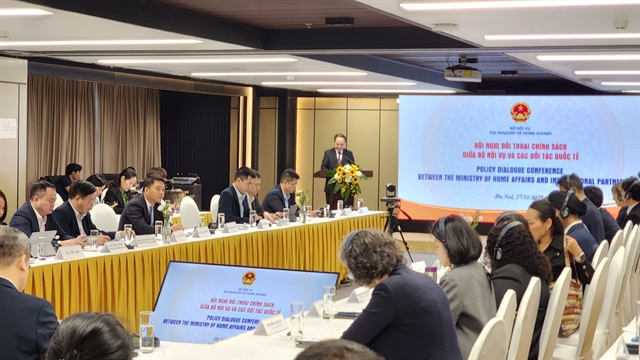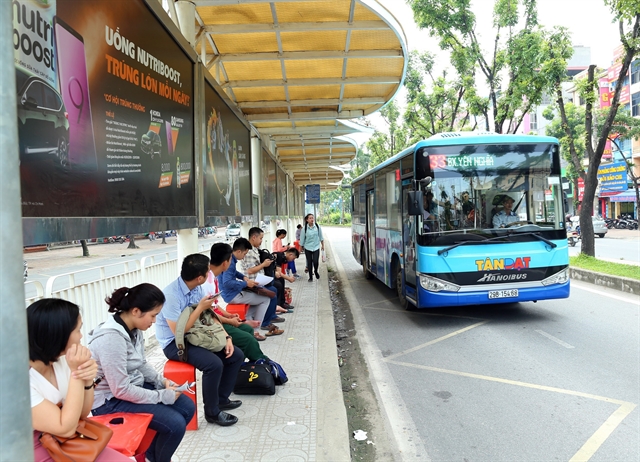 Society
Society

 |
| Buses pick up and drop off passengers on Nguyễn Trãi Street in Hà Nội. — VNA/VNS Photo Tuấn Anh |
HÀ NỘI — Many commuters in large cities such as Hà Nội are choosing private means of transport over public options, primarily due to weather-related concerns.
Sweating during the trek from home to the bus stop under the relentless summer sun, or dealing with tardiness brought on by unexpected changes in bus schedules due to rainfall and flooding, has resulted in a lack of enthusiasm towards public transit.
Trần Thái Sơn, a student at the Water Resources University in Hà Nội, abandoned the idea of using the bus for his commute to the university after merely a few weeks of trials.
The entire journey from his home to the bus stop and from there to the university spans approximately one kilometre. This can prove to be a daunting task for individuals who aren't accustomed to frequent physical exertion, like Sơn.
“It takes us lots of time to walk from our rented house or dormitory to big roads where bus stops are located.
“When it's hot outside, I feel too lazy to walk. I think that's part of the reason I choose a motorbike for travel,” he told Voice of Vietnam (VOV) online newspaper.
Although Hà Nội’s buses have been equipped with air conditioning, those who do not exercise often and sweat during summer are still hesitant to use public transport.
 |
| Passengers wait at Hoàng Quốc Việt bus transit station in Hà Nội. — VNA/VNS Photo Huy Hùng |
Lê Xuân Sơn, who lives in Hai Bà Trưng District and uses buses to travel daily, said he has to bring wet wipes, an umbrella and a mini fan to avoid the heat.
VOV gathered feedback explaining why daily commuters are disinclined to utilise public transport. A number of them attributed their dissatisfaction to the unpleasant odours caused by overcrowded buses during peak hours.
Others suggested an increase in bus stops, which would minimise the need to walk long distances in challenging weather conditions, be it under the intense sun or during downpours.
The difficulties with public transport are not only due to the summer heat; adverse weather conditions, such as rain, also interfere with its functionality.
Nguyễn Hoàng Yến, a resident of Long Biên District, regularly uses the bus for her daily commute. To keep track of bus schedules and routes, she employs the 'Bus Map' application.
However, during periods of significant flooding brought on by rainfall, app users are left without updates regarding bus schedule delays.
Without knowing the updated routes on rainy days, it becomes impossible to plan travel effectively, she said.
Yến expressed her hope that the app would incorporate weather condition updates and information on locations affected by flooding or traffic congestion, enabling commuters to devise more efficient travel plans.
Đào Khoa Thư, who has been a daily user of Hà Nội buses for a decade, noted that an increasing number of older individuals are opting for buses due to the provision of free tickets. However, she pointed out that the app does not cater well to this demographic, with small font sizes and an unclear user roadmap presenting challenges.
“I prefer using Google Maps for a more simple navigation interface and accurate bus route prediction,” she told Việt Nam News.
The capital city also has piloted bus rapid transit route (BRT) Kim Mã - Yên Nghĩa, running on a 12.9km route and Cát Linh - Hà Đông metro line.
Among 12 stations of the metro line, two stops at the start and the end of the line have parking lots for passengers’ vehicles.
Thư said: “Walking to the bus stop in less than 10 minutes in the hot weather is acceptable to me. I love taking the bus for the air conditioning, especially on longer trips. What I am scared of is crossing the roads to reach the bus stops.”
As of 2022, Hà Nội had over 150 bus routes with about 2,200 buses serving 340 million passengers.
There are about 4,400 bus stops. The average distance from each is 600m in the inner city area and 900m in the suburban areas.
In August, Hà Nội plans to launch a public bike service with 600 bicycles expected to connect public transport stops and encourage residents to use public transport.
Thư said: “I’m not sure if I will take the bike, because for those who often take the bus and rarely ride personal vehicles like me, I see it is too dangerous to ride a bike on the crowded Hà Nội streets.”
“Compared to other cities in the world where I lived, like New York, riding a bicycle in Hà Nội is very dangerous. In New York, I cycled 12km to school every day, but when I came back to Hà Nội, I decided to walk and take the bus.”
Proper planning
Nghiêm Quốc Thắng, vice chairman of Hà Nội Public Passenger Transport Association, said climate characteristics affect public transport in all countries. The problem is that planning and development need to be taken into consideration to suit each location.
“In some countries with hot weather all year round like Singapore, they build roads with trees to provide shade for people taking the bus,” Thắng said.
He proposed building more bus shelters to give people places to avoid the sun and rain.
Dr Vũ Anh Tuấn from the University of Transport said it is difficult for passengers to access public transport today because many Vietnamese people live in alleys, and buses only run on the main roads.
He said more bus stops would not improve accessibility. It is necessary to consider the impact of climate factors in the design stage.
“We have to connect and integrate with other modes of public transport, such as buses, to support urban railways. We must provide space to private vehicles to connect to means of public transport,” he said.
For example, we must build parking lots for bicycles and e-bikes next to metro lines, transit points and major bus stops. If we want to encourage the use of public transport, we must provide infrastructure and provide charging stations, he said.
Traffic expert Dr Nguyễn Hữu Đức said given the fact that the quality of public transport in Hà Nội is quite good, especially the air conditioning system, increasing accessibility is a solution to minimise the impact of the weather.
Globally, there exists a type of service known as "park and ride". These services establish stops in areas where people commonly congregate, such as shopping centres and parks. When the weather is fine, passengers can wait within the shopping centres. When the bus is due to arrive, they can then move outdoors, Đức explained.
He emphasised that the positioning of parking lots needs to be carefully considered. This planning strategy aims to determine the locations of public transport parking stations, trading centres, factories, and schools. — VNS




